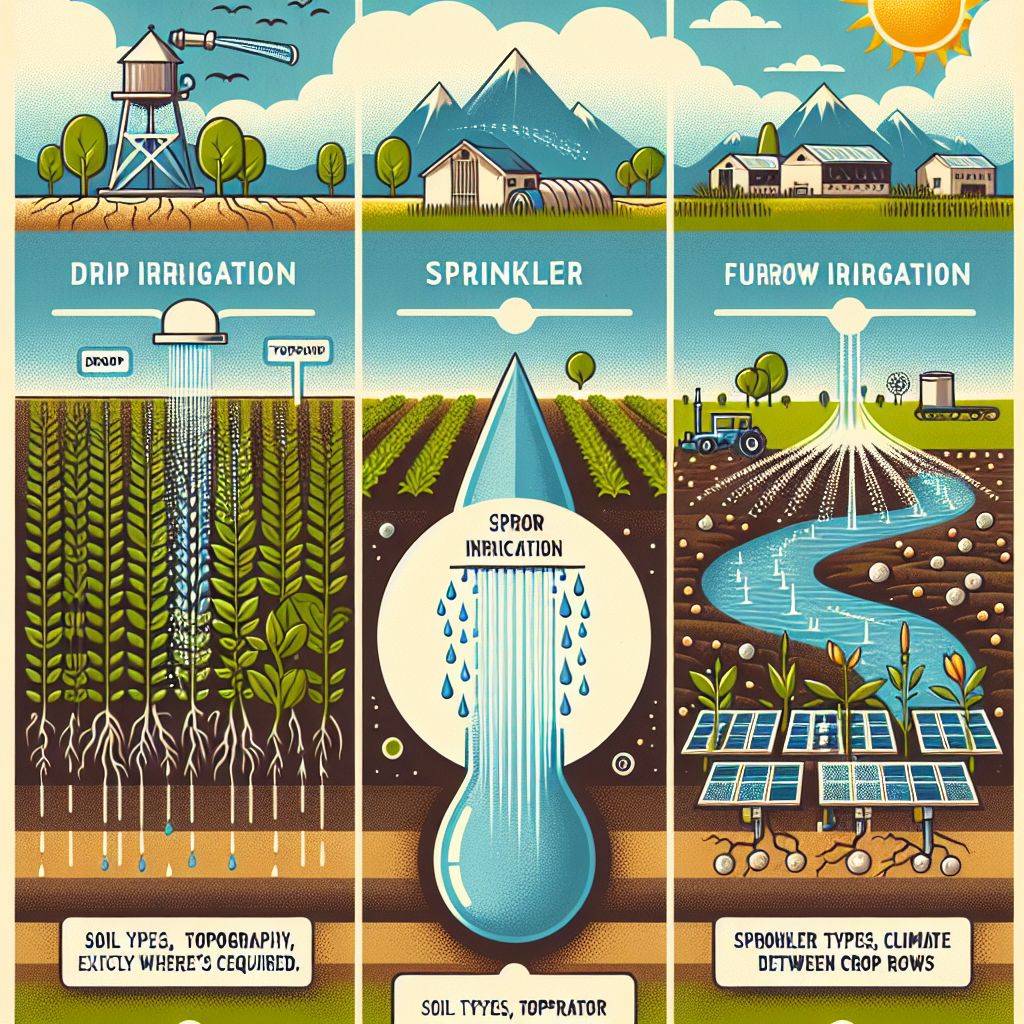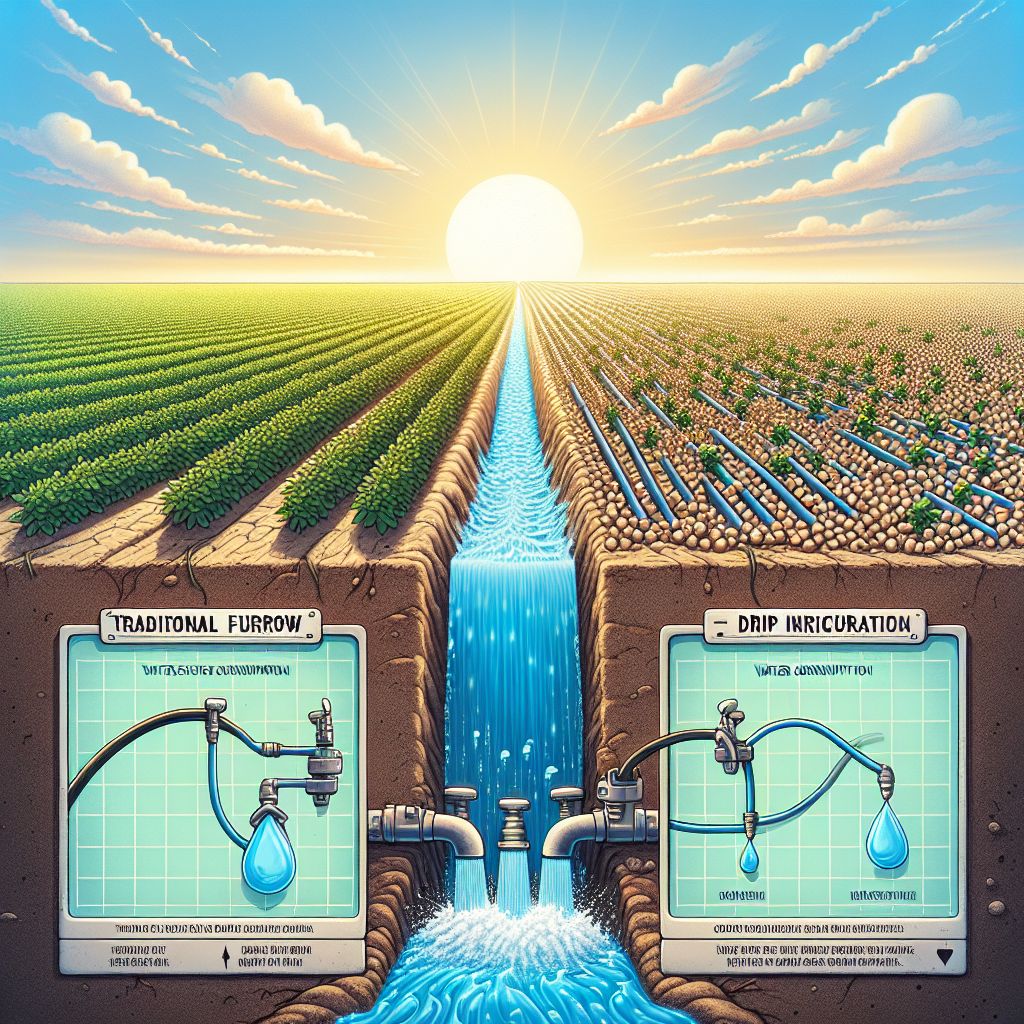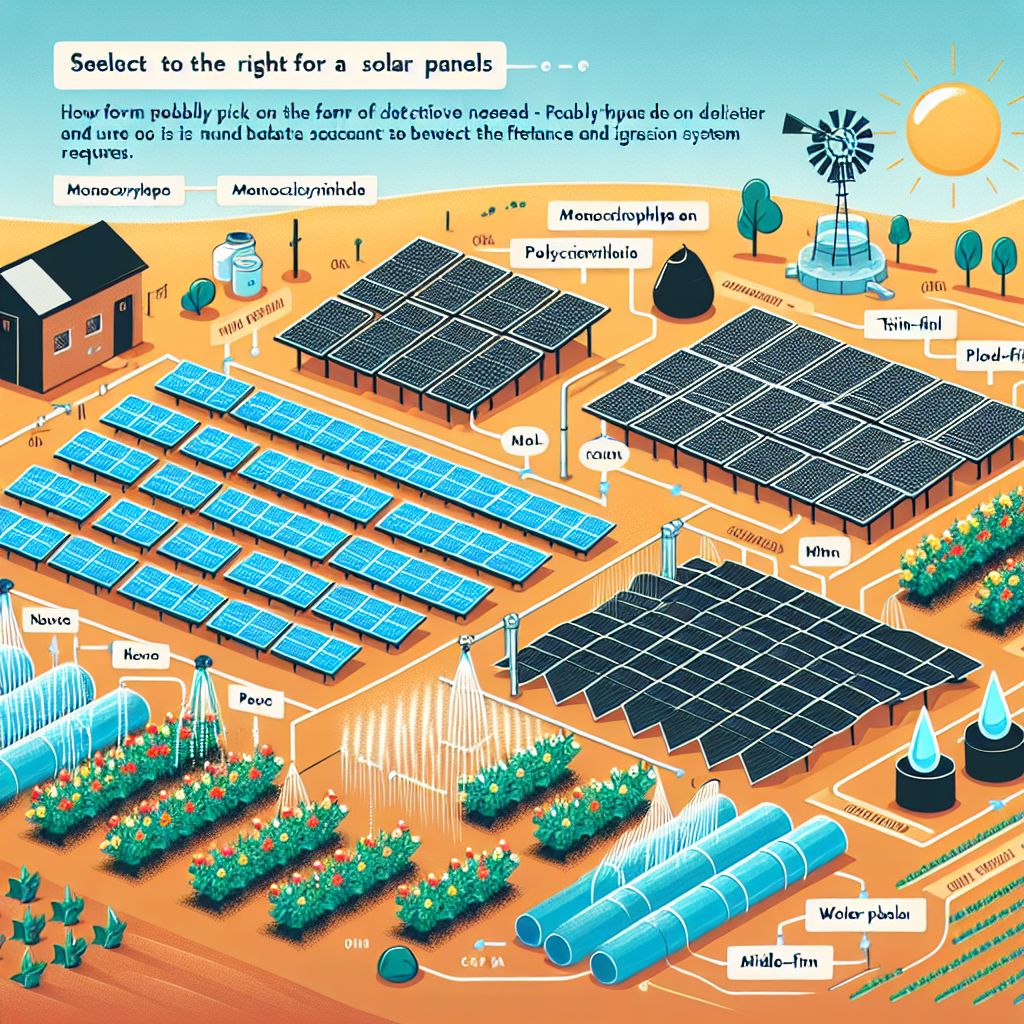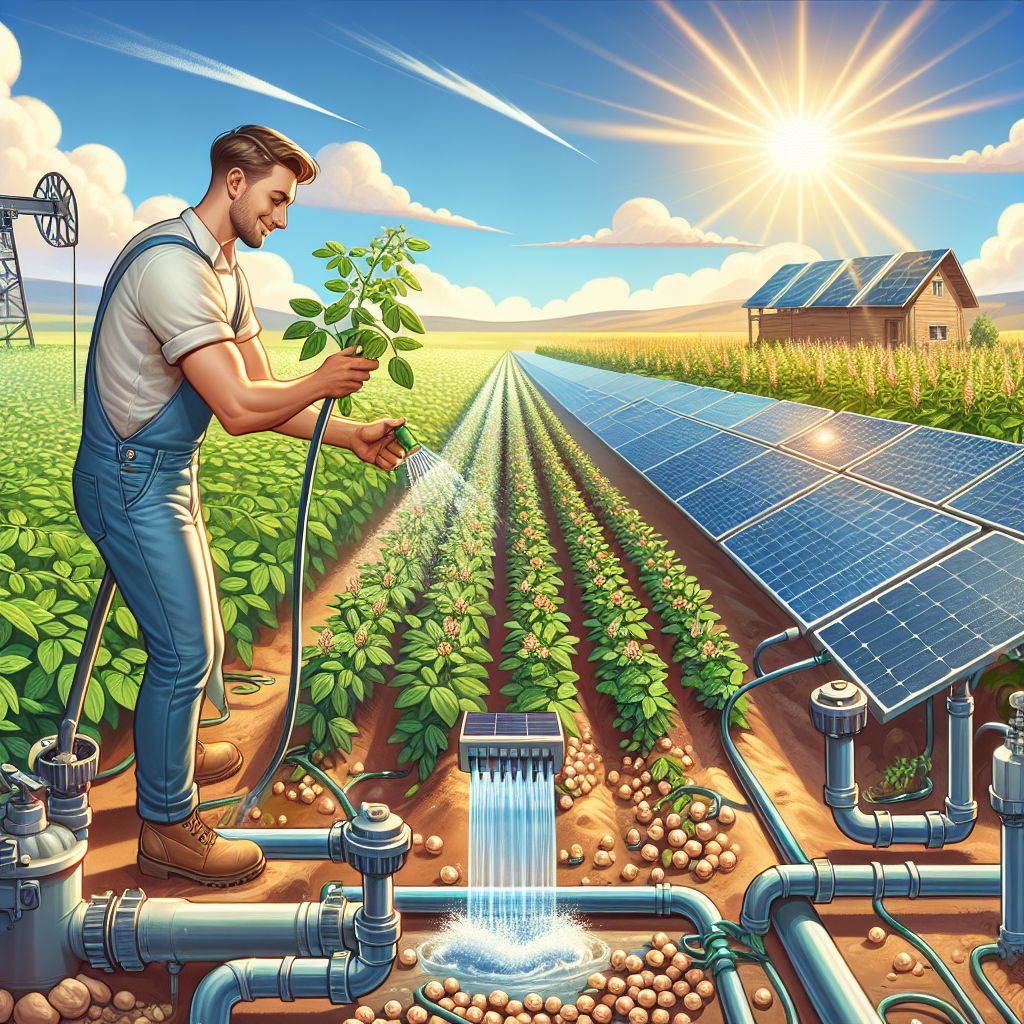
Key Points
Solar irrigation systems can greatly decrease water and energy usage in chickpea cultivation.
Drip irrigation is the most effective method, as it delivers water straight to the plant’s roots.
Selecting the right type of solar panel is vital for the irrigation system’s sustainability and efficiency.
Despite the initial investment being greater than traditional methods, the long-term savings from solar irrigation can be significant.
Government incentives may be available to help cover the cost of transitioning to solar-powered irrigation systems.
The Benefits of Pairing Solar Panels with an Irrigation System
Picture a farm where the sun not only ripens the chickpeas, but also powers the system that waters them. That’s the power of solar irrigation systems. By utilizing the energy of the sun, we can water crops like chickpeas in a way that’s not only friendly to our wallets over time, but also to the environment. So, why should you consider going solar? The answer is simple: sustainability and efficiency. Solar panels convert sunlight into electricity, which can then power irrigation systems without the need for grid power. This results in fewer greenhouse gas emissions and a reduced carbon footprint.
Water is a vital resource for chickpea farmers, as valuable as gold. Utilizing solar energy for irrigation allows you to pump the precise amount of water your crops require straight to their roots, ensuring no water is wasted. Additionally, you’re safeguarded against increasing energy prices because, after all, sunlight is free!
Decreases dependence on non-renewable energy sources.
Reduces water waste through precise irrigation.
Guards against fluctuating energy prices.
Comprehending the Advantages of Solar Energy in Agriculture
Let’s delve a little deeper into why solar energy is a game-changer for agriculture. Solar power is renewable, meaning it’s never going to be depleted – at least not for another few billion years. For farmers, this means a dependable source of energy that’s available every day the sun is out. Using solar energy for irrigation, particularly for water-intensive crops like chickpeas, means you’re utilizing a steady and sustainable power source to keep your crops flourishing.
Moreover, solar power systems have low operating costs. After the panels are installed, they require minimal maintenance, and the energy they generate is free. This is a significant advantage for farmers who want to minimize expenses and maximize profits.
Why Solar Power Makes Irrigation More Effective for Growing Chickpeas
So why are chickpeas and solar irrigation such a good fit? Chickpeas require a lot of water during certain growth phases, but too much or too little can damage the crop. Solar-powered drip irrigation systems can provide the exact right amount of water right to the root zone. This targeted watering encourages healthy growth and maximizes yield – all while using less water than traditional methods.
With solar power, you can continue to run your irrigation system even when there’s a power outage. This ensures your chickpeas are watered on time, regardless of the circumstances. This level of dependability can significantly impact your ability to produce a healthy, marketable crop.
Lowering Carbon Emissions and Enhancing Energy Self-Sufficiency
Adopting solar irrigation systems isn’t only about cost savings; it’s also about taking action for the environment. Farming is a major source of greenhouse gas emissions, but by going solar, you’re reducing your reliance on fossil fuels. This step lowers your carbon emissions and makes your farm part of the answer to global warming.
Moreover, achieving energy independence is a major advantage. By not depending on the grid, you gain more control over your farming processes and safeguard yourself from increases in energy costs. You are establishing a sustainable, self-reliant system that will provide benefits to your farm for many years into the future.

Various Irrigation Systems for Chickpea Cultivation
Chickpeas are adaptable and can thrive in a range of climates, but they all share one requirement: water. Let’s discuss the different methods to provide water to your chickpea plants.
“Selecting the correct irrigation system is akin to choosing the right tool for a task – it can significantly impact your crop’s yield.”
There are three primary kinds of irrigation systems: drip, sprinkler, and furrow. Each one offers its own advantages and is appropriate for different settings and types of crops.
A Look at Drip, Sprinkler, and Furrow Irrigation Techniques
Think of drip irrigation as a water bottle for your chickpeas. It’s accurate and efficient, providing water drop by drop exactly where it’s required. Sprinkler systems act like a rain shower, sprinkling water over a large area. Furrow irrigation, on the other hand, is an old-school method where water flows down little trenches between crop rows.
If you’re growing chickpeas, drip irrigation is the way to go. It saves on water and fertilizer, cuts down on weeds, and helps prevent disease by keeping water off the leaves. It’s a triple threat.
Choosing the Best Irrigation System for Your Chickpeas
There are a few key things you need to think about when choosing an irrigation system for your chickpeas:
Soil type: Does it retain water or does it drain fast?
Topography: Is your land flat or hilly?
Climate: Is your area rainy or arid?
Water source: How much water can you get?
Chickpeas don’t like wet feet, so drip irrigation is usually the best choice. However, every farm is unique, so you need to consider all these factors before making your decision.
Keep in mind, the correct system not only saves water and energy, but also yields healthier crops. When you couple that system with solar panels, you’re setting yourself up for long-term sustainability. It’s about making wise decisions now that will reap benefits for many years.
|
Irrigation System |
Description |
Advantages for Chickpeas |
Disadvantages for Chickpeas |
|---|---|---|---|
|
Drip Irrigation |
Water is delivered directly to the roots of plants through small tubes or emitters. 4, 5 |
– Precise water application to roots |
– High initial cost to install system. 5 |
|
Sprinkler Irrigation |
Water is sprayed over the field from overhead sprinklers. 4 |
– More efficient than flood irrigation |
– Risk of fungal diseases if foliage stays wet |
|
Furrow Irrigation |
Small channels or furrows are created between crop rows and water flows down the furrows. 2, 4 |
– Inexpensive system |
– Higher water losses than drip |

Comparing the Cost and Efficiency of Traditional Furrow and Modern Drip Irrigation Systems for Chickpea Cultivation
In chickpea farming, water is a precious resource. The age-old furrow irrigation technique, which involves pouring water between rows so it can soak into the soil, has been the go-to method for many farmers. But the advent of modern drip irrigation systems, which deliver water straight to the base of each plant, is revolutionizing the field. This method ensures that every drop of water is put to good use.
Let’s get down to brass tacks—or in this case, chickpeas. Yes, traditional furrow systems are cheaper to install, but they’re also less efficient. They can consume up to 50% more water than drip systems. And with water becoming an increasingly valuable resource, efficiency is the name of the game. That’s why many farmers are making the switch to drip irrigation, even though it’s more expensive to start with.
Comparing Water and Energy Usage
Water is the lifeblood of a farm. Switching to drip irrigation can cut water usage by as much as 60% compared to traditional furrow irrigation. That’s a significant saving, not only for the environment, but for your water bills as well. And when it comes to energy, drip systems that are powered by solar panels can operate using the energy they generate, which can reduce electricity costs and shrink the farm’s carbon footprint.
Here’s the deal: Drip systems trickle water into the soil, providing ample time for it to be absorbed and reducing the chance of runoff. This approach also ensures that the water penetrates deeper into the soil, promoting deeper root growth and healthier plants. Healthier plants translate to a better yield, and a better yield translates to more money for you.
Let’s get down to the nitty-gritty. Traditional furrow irrigation systems might require approximately 500 gallons of water per acre, whereas drip systems can reduce that amount to 200 gallons per acre. That’s a reduction of 300 gallons per acre, each time you irrigate. Now, multiply that by the size of your farm, and you’ll understand why drip systems are a smart investment.
“Think about the water a single farm could save by switching from furrow to drip irrigation. Now think about that on a worldwide scale!”
The Long-Term Financial Gains of Upgrading Irrigation Methods
This isn’t just about the present. There are substantial financial gains to be had over time from investing in a modern drip irrigation system. Yes, the initial setup costs might seem daunting, but the savings in water and energy quickly start to pile up. In many cases, the system pays for itself in just a few years.
Not to mention, the crop yield. Plants that are healthy and have enough water yield more crops. More yield means more to sell, and more to sell means more money. It’s a basic formula, but it’s effective. Farmers who have switched often report not just savings, but also increased earnings.

Choosing the Right Solar Panels for Your Chickpea Farm’s Irrigation System
You’ve decided that drip irrigation is the way to go for your chickpea farm, and now you’re ready to take it a step further with solar power. But which type of solar panels should you choose? There are several different types, each with its own advantages and disadvantages.
Which solar panel you pick will be influenced by a number of factors, such as your local weather, the size of your farm, and how much money you’re willing to spend. Don’t worry, we’ll go over all the choices to help you decide which one is the best fit for you.
Comparing Monocrystalline, Polycrystalline, and Thin-Film Solar Panels for Farming Purposes
When it comes to solar panels, there are three main types you’re likely to encounter: monocrystalline, polycrystalline, and thin-film. Here’s what you need to know:
Monocrystalline: These are the most effective and the most costly. They perform well in all weather conditions and occupy less space.
Polycrystalline: Slightly less effective than monocrystalline, but also less costly. They’re a good middle-ground choice.
Thin-Film: These are the least effective and least costly. They’re flexible and lightweight, making them easy to install on a variety of surfaces.
For a chickpea farm, you’ll probably want to choose monocrystalline or polycrystalline panels. They offer the best balance of effectiveness and cost, ensuring you get the most value for your money.
Choosing the Appropriate Panel Size and Capacity for Your Farm
Size is important, but capacity is too. You need to determine how much power your irrigation system requires and then select panels that can provide that. It’s a bit like solving a puzzle – you need to ensure all the pieces fit together.
Here’s a helpful hint: begin by examining the wattage of the pumps in your irrigation system. After that, think about how many hours of sunlight your farm receives. With these two pieces of information, you can figure out how many panels you’ll need to keep your system running smoothly.
Remember to consider future growth. If you aim to expand your farm, select panels that can grow with your farm. It’s all about future planning.
Right below is a table looking at all the different solar panel options:
|
Solar Panel Type |
Efficiency Range |
Advantages |
Disadvantages |
|---|---|---|---|
|
Monocrystalline |
17-22% |
Highest efficiency, space-saving, long lifespan. 2 | |
|
Polycrystalline |
15-17% |
Lower efficiency, requires more space. 2 | |
|
Thin-Film |
10-13% |
Lightweight, flexible, good temperature coefficient. 2 |
Lowest efficiency, requires large area. 2 |
|
Portable Solar Panel Systems |
Varies based on panel type |
Designed for irrigation needs, easy to move and relocate. 1, 3 | |
|
Hybrid Solar Panels |
Varies based on components |
Can combine solar with other energy sources like wind, increased reliability. 4 |
More complex system, higher cost. 4 |
Monocrystalline panels provide the highest efficiency in a compact area but at a higher upfront cost (2, 3). Polycrystalline panels offer a balance of efficiency and cost (2, 3). Thin-film panels have lower efficiency but perform better in high temperatures (2). Portable solar panel irrigation systems allow flexibility in placement and relocation as needed (1). Hybrid systems increase reliability by combining solar with other renewable sources but add complexity (4). The optimal choice depends on factors like available space, budget, local climate conditions, and specific irrigation requirements for chickpeas.

Comparing the Cost and Efficiency of Solar Irrigation Systems and Traditional Irrigation Systems in Chickpea Cultivation
While the initial cost of traditional irrigation systems may seem more appealing, a closer look reveals that solar irrigation systems are actually more cost-effective in the long run. Not only do they provide more efficient watering solutions, but they also contribute to the sustainability of your farm and the environment.
Let me simplify it for you. A traditional irrigation system might have a lower initial cost, but you’ll be shelling out for water and energy on a monthly basis. A solar irrigation system may cost more at the outset, but once it’s operational, the sun takes care of most of the heavy lifting.
So, what’s the real deal? The savings on water and energy over time can be substantial. We’re talking about a potential of thousands of dollars annually. Considering that solar panels have a lifespan of about 25-30 years, that’s a lot of savings.
More expensive initial cost for solar irrigation.
Substantial savings on water and energy expenses over time.
Improved crop production due to better water distribution.
Keep in mind, although the initial outlay may appear high, you’re preparing for years of lower expenses and increased production. It’s a wise decision for any farmer who wants to remain competitive and sustainable.
Case Studies: Farmers Who Have Transitioned to Solar-Irrigated Chickpea Farming
Let’s look at some real-life examples. Consider John, a chickpea farmer in California. He made the switch to solar-powered drip irrigation and saw his water usage decrease by 40%. His energy costs were reduced, and his crop yields increased. It was a beneficial situation that positively impacted his profit margin.
Take Maria from Spain, for example. She opted for polycrystalline solar panels to power her irrigation system. This not only helped her cut down on her carbon emissions, but she also saw a 25% increase in her chickpea harvest. Hers is just one of the many stories that highlight the advantages of solar power.
“Since I started using solar irrigation, I’ve noticed a decrease in my expenses and an increase in my earnings. It’s one of the best choices I’ve made for my farm.” – John, Chickpea Farmer
ROI Assessment of Solar Irrigation Systems in Chickpea Farming
The bottom line is return on investment (ROI). The ROI for solar irrigation systems can be quite substantial. It’s not unusual for farmers to recover their investment in as little as 3-5 years, thanks to the money saved on water and energy.
However, the benefits of solar irrigation systems go beyond the financial. There’s also the ecological return on investment to consider. By using less water and producing your own green energy, you’re making a positive impact on the environment. That’s a benefit that all of us share, and it’s a return that can’t be quantified in mere monetary terms.
Ultimately, solar irrigation systems for chickpea cultivation are a wise investment for farmers seeking to enhance productivity, cut down on expenses, and contribute to environmental conservation. It’s a viable strategy that is advantageous from all perspectives.
Wrapping Up:
In conclusion, solar irrigation systems offer a game-changing solution for chickpea farmers. Adopting this technology will not only improve water efficiency but also harness renewable energy, reducing operating expenses and environmental footprint. Despite the substantial upfront cost, the long-term savings, higher crop yields, and environmental advantages make solar irrigation a smart investment for the future of agriculture.
Common Questions and Answers
Switching to solar irrigation for growing chickpeas can be a big decision. To help you make an informed choice, we’ve compiled some of the most frequently asked questions about this process.
Why are Solar Irrigation Systems More Efficient Than Traditional Methods?
Solar irrigation systems are more efficient because they harness the power of the sun to run pumps and other machinery, removing the need for electricity or diesel. Furthermore, when used in combination with drip irrigation, they deliver water right to the plant’s roots, reducing evaporation and runoff, which are common problems with traditional methods like furrow irrigation.
This accurate water delivery method guarantees that plants get the perfect quantity of water without any wastage, resulting in better water preservation and stronger crops. Furthermore, the use of solar power ensures that watering can happen during peak sunlight hours when plants are most thirsty, further boosting effectiveness.
Are Solar Irrigation Systems Suitable for All Weather Conditions?
Solar irrigation systems are adaptable and can work well in a range of weather conditions. They are especially effective in areas with a lot of sunshine. But, even in places where the sun doesn’t shine as consistently, solar panels can store energy in batteries for use when it’s cloudy or at night. It’s crucial to get the system size right for your particular weather to ensure it runs smoothly all the time.
Plus, improvements in solar technology have made panels better at turning sunlight into power, even on cloudy days. So, while performance can differ, solar irrigation systems can be adjusted to work well in most climates.
What Kind of Upkeep is Required for Solar-Powered Irrigation Systems?
Solar-powered irrigation systems are generally low-maintenance. The main parts, such as the solar panels and batteries, should be kept clean and clear of any debris to work at their best. Regular inspections of the system, including the pumps, valves, and drip lines, are necessary to make sure everything is running smoothly.
Solar panels typically last between 25 to 30 years, and many manufacturers offer warranties that cover a large part of this time frame. Regular upkeep, including securing loose connections and replacing parts that are showing signs of wear, can help prolong the system’s lifespan and keep it running efficiently.
What Effect Does Solar Irrigation Have on the Growth and Yield of Chickpeas?
The use of solar irrigation systems can greatly benefit the growth and yield of chickpeas. The consistent and precise delivery of water these systems provide helps keep the soil at the ideal moisture level, which is key for the development of chickpeas. Drip irrigation, specifically, reduces water stress on the plants, which can result in better growth and possibly increased yields.
Moreover, using renewable energy for irrigation lessens the chance of soil and water pollution from fossil fuels, creating a more beneficial growth environment for chickpeas. Through accurate water management, farmers can also decrease the occurrence of diseases and pests, which in turn improves crop yield.
Do Government Incentives Exist for Solar Irrigation Technology Adoption?
Various governments globally provide incentives for the adoption of renewable energy technologies, such as solar irrigation systems. These incentives may be in the form of grants, low-interest loans, tax credits, or rebates, all of which can help reduce the initial investment costs.
Farmers should take the time to investigate the particular incentives in their area. These can greatly lower the financial hurdles to adopting solar irrigation. Agricultural development or renewable energy groups can offer advice and help in obtaining these incentives.
Solar irrigation systems are becoming increasingly popular in agriculture, offering a sustainable and cost-effective solution to traditional watering methods. Among the various crops that can benefit from these systems, chickpeas are a prime candidate. Chickpeas require consistent moisture levels for optimal growth, and the precision of solar irrigation systems can provide just that, reducing water waste and ensuring that water use is optimized to meet the crop’s specific needs.







Leave a Reply